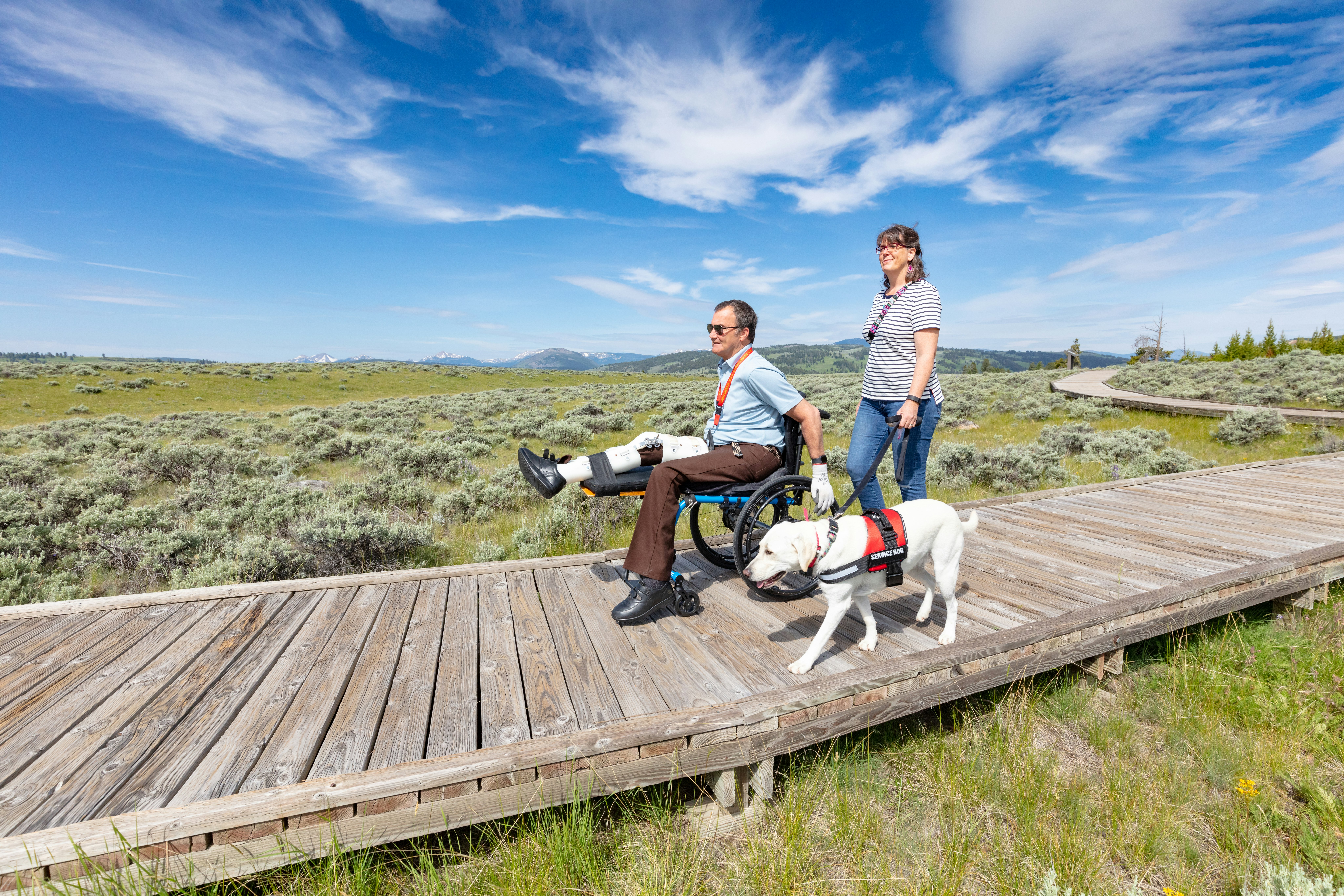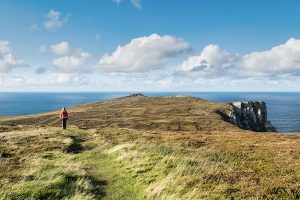
One July evening on my first trip to Yosemite National Park, my partner and I took a leisurely swim in Mirror Lake. As warm orange alpenglow from the setting sun lit up the face of Half Dome, we waded into the small but deep pool, the imposing peak towering directly above us. The lake was emptying quickly, as other travelers hurried to hike back to their cars before dark. Soon, it was just us and the glowing mountaintops. The sounds of evening settled around us, and I felt a surge of awe and gratitude to be there to witness night falling on this utterly remarkable place.
Under normal circumstances, I wouldn’t have been able to visit Mirror Lake at all. Most Yosemite visitors access it via a two-mile hike. My fibromyalgia, a systemic connective tissue disorder, makes that impossible; more than 20 minutes of walking is just too painful under most circumstances. But the day before, on a whim, I had asked at the park gate if they ever gave out temporary disability placards for people like me – someone with mobility limitations that don’t qualify for a government placard but who could use some help in order to experience the park fully. To my surprise, the woman at the gate said yes.
That placard transformed my visit to Yosemite, giving me access to whole swaths of the park (like Happy Isles) that would otherwise be accessible only by foot, allowing me to more easily admire the stunning alpine scenery and have my sunset alone with Half Dome. Anyone can ask for a placard if they need it. And, as it turns out, Yosemite is not the only park to give them out. Many national parks are looking for ways to better serve travelers with disabilities these days. Here are just a few of the parks that are doing it right. (By the way, US citizens or permanent residents of the US who have been medically determined to have a permanent disability can get free, lifetime access pass).
 The national parks continue to expand their accessibility programs © 24K-Production / Shutterstock
The national parks continue to expand their accessibility programs © 24K-Production / Shutterstock
1. Yosemite National Park, California
The temporary placard that made so much possible for me is only the beginning of the thoughtful and thorough accessibility measures in place here. A brand-new path and viewing area under construction at towering Bridalveil Fall will be wheelchair accessible. And Mariposa Grove, a wonderful place to see giant sequoias, recently got a new wheelchair-accessible boardwalk, plus tactile maps and displays throughout the Grove for low vision visitors. Sadly, the Grove sustained major storm damage in winter 2021. Visitors with permanent and temporary placards can still drive the restricted road to the Mariposa Grove Arrival Area, but the accessible parking area near the 3000-year-old Grizzly Giant tree is closed. Check the Yosemite website for up-to-date information.
Plus, Yosemite provides a panoply of disability-friendly programming for people of all kinds of access needs. With enough notice, the accessibility team can provide tours, presentations and hikes for visitors with low vision, with mobility issues or who are on the autism spectrum. They’ve also sprinkled a collection of tactile maps of Yosemite Valley and popular viewpoints throughout the park, so blind visitors can experience the landscape everyone else is enjoying.
But Yosemite’s crown access jewel is its Deaf Services program, which dates back to the 1970s. Deaf and hard-of-hearing travelers have access to a public videophone and to specialized kits providing items like a shake-awake alarm clock and a smoke alarm light flasher if they’re staying in a park lodge. They also can request personalized help from the park’s dedicated Deaf Services Coordinator, who is available to help plan their visits beforehand, meet them when they arrive, attend programs with them as an ASL interpreter and lead private talks and walks for Deaf groups in ASL. This kind of attention to the Deaf community has not escaped notice, and the park sees a notably high number of Deaf and hard of hearing visitors. It celebrates that community and its history every five years with a celebration that includes campfires, storytelling and tram tours of the valley – all in ASL.
The world’s most wheelchair-accessible travel destinations
 The special sand-roving wheelchairs available for rent at Sand Dunes National Park © Patrick Myers / NPS
The special sand-roving wheelchairs available for rent at Sand Dunes National Park © Patrick Myers / NPS
2. Great Sand Dunes National Park & Preserve, Colorado
Sand is one of the great nemeses of wheelchair users, walker users and anyone with balance issues. For a place that’s known for its enormous, eerie sand dunes, Great Sand Dunes National Park & Preserve is surprisingly accessible. Wheelchair users can reserve specialized rides with blow-up wheels for traversing sand, making exploring the unearthly beauty of the dunes something more than a non-starter. (Note that you’ll still need to go with a partner, though, and that the wheelchairs can be hard to push!) For visitors who prefer to remain stationary or who want to focus on the more visual aspects of the park, the park has helpful tips on drawing the dunes.
Plus, Great Sand Dunes is known for its clear, dark skies. (As its website says, “Half the park is after dark!”) NPS offers evening programs from accessible amphitheaters on many summer nights.
Get more travel inspiration, tips and exclusive offers sent straight to your inbox with our weekly newsletter.
3. Rocky Mountain National Park, Colorado
The majesty of the Rockies is impressive any time of year, but Rocky Mountain National Park offers a particular multisensory delight in the fall season, through late October. The drive on Old Fall River Road to Trail Ridge Road will wind you through the spires and points of the alpine tundra. That’s a treat enough on its own, especially for people who like a side of geology with their outdoor travel.
But what you’re here for is the elk. An hour before sunset, pick a picnic spot in one of the meadows, enjoying the long shadows of golden hour. Soon, you’ll hear the males bugling in the distance, a haunting whistle coming down the mountains as they prepare for battle. If you’re lucky, the sounds will come closer and closer until the buglers themselves come out into the meadow to fight for the right to claim a mate. It’s a unique experience for people with all kinds of accessibility needs.
Plus, Rocky Mountain has done a lot of work to make its many beautiful hiking trails accessible for wheelchairs and walkers. Bear Lake Trail, Coyote Valley Trail, Sprague Lake Trail and Lily Lake Trail are all wheelchair accessible (although some large rocks make the last a bit of a challenge). And you can expect to see the grade listed on hills in at least some places to help users decide what makes sense for them. Forest Canyon Overlook trail is a particular stand-out, with a short, paved and accessible path leading to gorgeous canyon views.
Take a spin around the globe with an accessible travel expert
 Exploring the Forces of the Northern Range boardwalk in Yellowstone © Jacob Frank / NPS
Exploring the Forces of the Northern Range boardwalk in Yellowstone © Jacob Frank / NPS
4. Yellowstone National Park, Idaho, Montana, Wyoming
Speaking of multisensory experiences, it doesn’t get much better than Yellowstone. Beyond the dayglo colors of the thermal features and the crash of waterfalls, there’s another element to a Yellowstone visit that can’t be denied: its signature sulfurous scent. It might not be your favorite perfume, but it does make for a powerful reminder: something amazing is happening here. In addition to savoring the olfactory adventure, blind and low-vision travelers can download an audio-described park guide, request a Braille park brochure or download a copy in Braille Ready Format. Ranger programs can provide Sign Language Interpreters with three weeks advanced notice.
Rotten eggs aside, one characteristic of a great national park for travelers with disabilities is the amount of it you can see from a vehicle or boardwalk, and Yellowstone has this in spades. Many of its thermal features are wheelchair accessible, with clear signage about what’s passable for people on wheels. The drives that crisscross this enormous park provide stunning views of its unique mix of ecosystems and out-of-this-world geology.
The Virginia Cascade grand loop, for example, will bring you to an isolated meadow with great picnicking and a decent chance at sighting a bear or deer. The Firehole Lake drive takes you through some of the best of the park’s thermal areas – plus there’s almost always bison around. An adventure at Lamar Valley provides remarkable alpine views, with the possibility of spotting a grizzly or wolf. These drives are also great for people with sensory processing issues. Yellowstone can get pretty crowded during peak times, and it’s sometimes hard to find places away from people.
 One of the accessible routes through the forest at Sequoia National Park © JLPH / Getty Images
One of the accessible routes through the forest at Sequoia National Park © JLPH / Getty Images
5. Sequoia & Kings Canyon National Parks
There’s nothing quite like seeing a Giant Sequoia for the first time at Sequoia & Kings Canyon National Parks. The trees are simply too huge to comprehend, towering overhead to create a shady cathedral in greens and browns. A walk through a sequoia grove is a multisensory bonanza. Not just the sights but the smells and sounds – the sweet-musty scent of pine needles, the creak and sigh as the enormous trees shift in the wind, the spongy-light texture of fire-scarred bark – create a peaceful atmosphere that’s unique to these woods. A visit to these parks would be worthwhile for people with all kinds of sensory and mobility needs even without the extensive disability access measures in place.
The parks now have an accessibility film series that outlines some of the accessible features and facilities.
The General Grant Grove is a highlight for any Sequoia/Kings Canyon visitor. The short, wheelchair-accessible (though sometimes a bit steep) trail meanders through sequoias the size of apartment buildings, culminating at the Grant Tree, which is the world’s third-biggest. And Braille text and tactile features along the trail help blind and low-vision travelers learn more about what they’re experiencing. (Bring gloves! The braille signs can be cold in the winter.) Taking an, um, leaf from its big brother Yosemite, Sequoia/Kings Canyon offers free ASL interpretation for any scheduled program with a week’s notice, as well as Deaf guest kits at Wuksachi lodge.
Travelers with mobility issues can borrow wheelchairs from multiple points and use them anywhere within the parks. Temporary accessible placards like the one I used at Yosemite are usually also available on request at entrances to the park.
Panoramic Point and Roaring River trails are especially good for hikers who need level and flat terrain.
6. Golden Gate National Recreation Area
It’s not technically a national park, but Golden Gate National Recreation Area is doing such cool accessibility work – and has so many beautiful and interesting things to see – that it’s worth mentioning to put on your vacation bucket list. The National Recreation Area encompasses an array of gorgeous northern-California-style beaches (think dramatic cliffs plunging into blue waves, whales spouting offshore, views of the Golden Gate Bridge) plus the atmospheric history of Alcatraz Island and the dappled wonderland of Muir Woods. Golden Gate has been hard at work in recent years implementing accessibility measures all over the place.
With advanced notice, beach wheelchairs are available on-site at Stinson Beach, Muir Beach, Rodeo Beach and Baker Beach for wheelchair users craving sun and sand, using a code and on-site locker. Plus, the Area offers a series of ASL videos talking about access and things to see in its various parks, as well as an ASL tablet tour of Alcatraz Island. Hard-of-hearing visitors preferring to go on tours in English can also request assisted listening devices.
Plus, Golden Gate has spent the last decade in partnership with the San Francisco non-profit LightHouse for the Blind and Visually Impaired, creating audio-described tours and large print, Braille and tactile maps of many of the Area’s best spots. The hope is that, along with the sounds of gulls wheeling above and the splash of waves, these resources can more fully bring the magic of the Bay Area to life for blind and low vision visitors.
Check out Lonely Planet’s comprehensive guide to accessible travel online resources here.
You might also like:
Accessible England: ten of the best places for visitors with a disability
What I have learned from travelling the world with a wheelchair
Accessible travel in Italy


